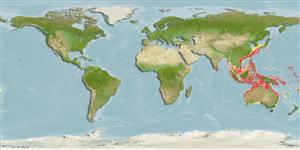Environment: milieu / climate zone / depth range / distribution range
Ecologia
marinhas demersal; intervalo de profundidade 50 - 150 m (Ref. 90102). Tropical
Indo-West Pacific: Nicobar Islands and throughout most of the Indo-Australian Archipelago, north to southern Japan (Ref. 9774).
Tamanho / Peso / Idade
Maturity: Lm ? range ? - ? cm
Max length : 40.0 cm SL macho/indeterminado; (Ref. 9774); common length : 25.0 cm SL macho/indeterminado; (Ref. 9774)
Espinhos dorsais (total) : 0; Raios dorsais (total) : 72 - 78; Espinhos anais: 0; Raios anais : 56 - 63; Vértebras: 36. Above and below lateral line with 1 or 2 pairs of distinct double ocelli. Many darker rings and spots scattered on body and median fins. Body ovoid, its depth 2.2 to 2.4 times in SL. Head length 3.4 to 3.7 times in SL. Upper profile of head strongly notched in front of upper eye. A line connecting base of first dorsal-fin ray and posterior nostril on eyed side crosses maxilla. Snout protruded, its length 1 to 1.3 times of eye diameter. Eye diameter 4.3 to 5 times in head length. Maxilla extending to below or beyond middle of lower eye. Teeth in both jaws small, without strong canines (Ref 9774). Gill rakers palmate, as broad as long. Two to four large double ocelli on body (Ref. 559).
Inhabits muddy and sandy bottoms of the continental shelves. Feeds on fish (Ref. 30463, 48637) and small benthic animals. Marketed fresh (Ref. 9774).
Ciclo de vida ou comportamento de acasalamento
Maturidade | Reprodução | Desova | Ovos | Fecundidade | Larvas
Distinct pairing (Ref. 205).
Masuda, H., K. Amaoka, C. Araga, T. Uyeno and T. Yoshino, 1984. The fishes of the Japanese Archipelago. Vol. 1. Tokai University Press, Tokyo, Japan. 437 p. (text). (Ref. 559)
Status na Lista Vermelha da UICN (Ref. 130435: Version 2024-2)
Ameaça para os humanos
Harmless
Uso pelos humanos
Pescarias: espécies comerciais
Ferramentas
Relatórios especiais
Baixar XML
Fontes da internet
Estimates based on models
Preferred temperature (Ref.
123201): 20.5 - 28, mean 25.7 °C (based on 405 cells).
Índice de diversidade filogenética (Ref.
82804): PD
50 = 0.5000 [Uniqueness, from 0.5 = low to 2.0 = high].
Bayesian length-weight: a=0.00724 (0.00338 - 0.01553), b=3.17 (3.00 - 3.34), in cm total length, based on LWR estimates for this Genus-body shape (Ref.
93245).
Nível Trófico (Ref.
69278): 4.2 ±0.73 se; based on food items.
Resiliência (Ref.
120179): médio(a), tempo mínimo de duplicação da população 1,4 - 4,4 anos (Preliminary K or Fecundity.).
Fishing Vulnerability (Ref.
59153): Moderate vulnerability (39 of 100).
